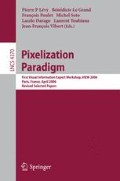Abstract
Brain functioning comprehension is an actual challenge. However the cerebral recordings produce a huge amount of data, it is difficult to select the pertinent data with the studied task. As we favor the dialog with the expert, we developed a methodology based on visualization. All steps are discussed and validated by the neurophysiologist as they still keep the link with the biological process.
The presented method is based first on extraction of oscillatory information from time-frequency transform. These ones are organized in a graph structure. Finally graph-matching techniques bring indication signals variations such as frequency, time or power variations.
Access this chapter
Tax calculation will be finalised at checkout
Purchases are for personal use only
Preview
Unable to display preview. Download preview PDF.
References
Varela, F., Lachaux, J.P., Rodriguez, E., Martinerie, J.: The brainweb: phase synchronization and large-scale integration. Nat. Rev. Neurosci. 2(4), 229–239 (2001)
Elul, R.: The genesis of the EEG. Int. Rev. Neurobiol. 15, 227–272 (1971)
Friston, K., Stephan, K., Frackowiak, R.: Transient phase-locking and dynamic correlations: Are they the same thing? Human Brain Mapping 5, 48–57 (1997)
Pereda, E., Quiroga, R.Q., Bhattacharya, J.: Nonlinear multivariate analysis of neurophysiological signals. Prog. Neurobiol. 77(1-2), 1–37 (2005)
Rappelsberger, P., Petsche, H.: Probability mapping: power and coherence analyses of cognitive processes. Brain Topogr. 1(1), 46–54 (1988)
Nunez, P.L., Srinivasan, R., Westdorp, A.F., Wijesinghe, R.S., Tucker, D.M., Silberstein, R.B., Cadusch, P.J.: EEG coherency. I: Statistics, reference electrode, volume conduction, Laplacians, cortical imaging, and interpretation at multiple scales. Electroencephalogr Clin. Neurophysiol. 103(5), 499–515 (1997)
Lachaux, J.P., Lutz, A., Rudrauf, D., Cosmelli, D., Quyen, M.L.V., Martinerie, J., Varela, F.: Estimating the time-course of coherence between single-trial brain signals: an introduction to wavelet coherence. Neurophysiol. Clin. 32(3), 157–174 (2002)
Schack, B., Rappelsberger, P., Vath, N., Weiss, S., Möller, E., Griessbach, G., Witte, H.: EEG frequency and phase coupling during human information processing. Methods Inf. Med. 40(2), 106–111 (2001)
Marple, S.: Digital Spectral Analysis with Applications. Prentice Hall, Upper Saddle River (1987)
Kaminski, M., Blinowska, K., Szclenberger, W.: Topographic analysis of coherence and propagation of EEG activity during sleep and wakefulness. Electroencephalogr. Clin. Neurophysiol. 102(3), 216–227 (1997)
Baccala, L.A., Sameshima, K.: Partial directed coherence: a new concept in neural structure determination. Biol. Cybern. 84(6), 463–474 (2001)
Durka, P.J.: From wavelets to adaptive approximations: time-frequency parametrization of EEG. Biomed. Eng. Online. 2(1), 1 (2003)
Meyer, Y.: Wavelets and operators (Translated from the 1990 French original by Salinger, D.H). In: Cambridge Studies in Advanced Mathematics, vol. 37, Cambridge University Press, Cambridge (1992)
Beucher, S., Meyer, F.: The morphological approach to segmentation: The watershed transformation. In: Mathematical Morphology in Signal Processing, pp. 433–481. Marcel Dekker Inc., New York (1993)
Bernard, M., Richard, N., Paquereau, J.: Functionnal brain imaging by eeg graph-matching. In: 27th annual conference of the IEEE Engineering in Medecine and Biology Society(EMBC’05), Shanghaï, Chine, IEEE, Los Alamitos (2005)
Nilsson, N.: Principles of Artificial Intelligence. Symbolic Computation. NIL n 82:1 1.Ex. Springer (1982)
Gold, S., Rangarajan, A.: A graduated assignment algorithm for graph matching. IEEE Trans. Pattern Anal. Mach. Intell. 18(4), 377–388 (1996)
Ranganath, H.S., Chipman, L.J.: Fuzzy relaxation approach for inexact scene matching. Image Vision Comput. 10(9), 631–640 (1992)
Pfurtscheller, G., da Silva, F.H.L.: Event-related eeg/meg synchronization and desynchronization: basic principles. Clinical Neurophysiology 110(11), 1842–1857 (1999)
Author information
Authors and Affiliations
Editor information
Rights and permissions
Copyright information
© 2007 Springer Berlin Heidelberg
About this paper
Cite this paper
Bernard, M., Richard, N., Paquereau, J. (2007). Time Frequency Representation for Complex Analysis of the Multidimensionality Problem of Cognitive Task. In: Lévy, P.P., et al. Pixelization Paradigm. VIEW 2006. Lecture Notes in Computer Science, vol 4370. Springer, Berlin, Heidelberg. https://doi.org/10.1007/978-3-540-71027-1_20
Download citation
DOI: https://doi.org/10.1007/978-3-540-71027-1_20
Publisher Name: Springer, Berlin, Heidelberg
Print ISBN: 978-3-540-71026-4
Online ISBN: 978-3-540-71027-1
eBook Packages: Computer ScienceComputer Science (R0)

